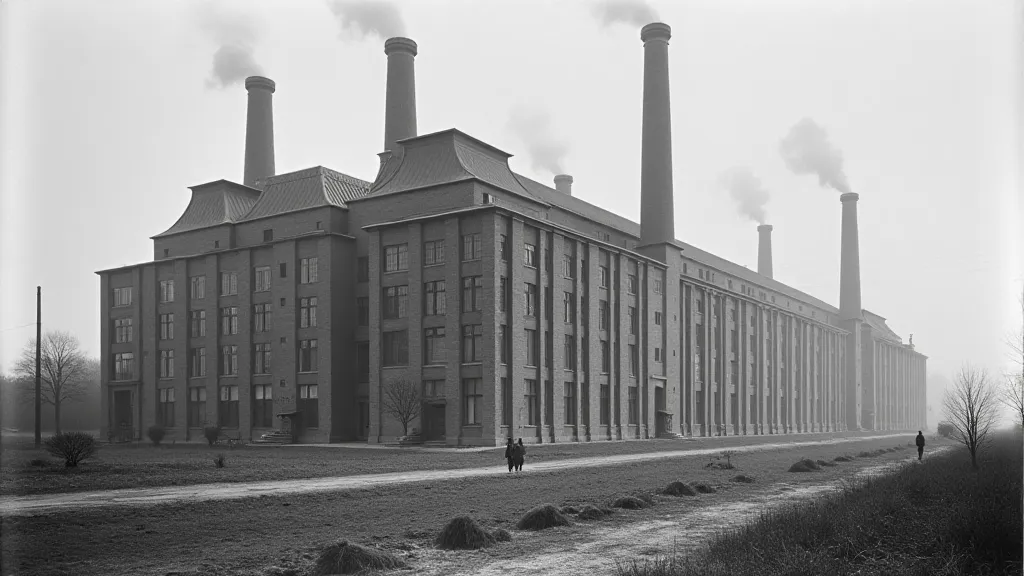The Memory of Smoke: How Factories Left Their Mark on Cityscapes
The city breathes, doesn’t it? We feel it in the rush of traffic, the murmur of voices, the rise and fall of buildings against the sky. But listen closer. There’s another layer to that breath, a fainter exhalation of industry, of relentless labor, of a time when the air itself tasted of coal dust and ambition. It’s a memory woven into the very stones and brickwork of our urban landscapes, the ghostly residue of factories that once pulsed with life, now silent monuments to a vanished era. These aren't simply abandoned buildings; they are physical embodiments of a profound shift in human history, landscapes scarred and reshaped by the relentless engine of industrial progress.
My grandfather, Samuel, worked in a textile mill. He rarely spoke of it, the memories too ingrained, too heavy. But the few stories he did tell – fragments of clattering machinery, the constant hum of looms, the palpable exhaustion etched on the faces of his colleagues – painted a vivid portrait of a world dramatically different from our own. He's gone now, but the echo of that world lingers in the abandoned mills dotting the landscape of New England, in the crumbling brick facades and the skeletal remains of powerhouses. They are whispers of his story, and the story of millions like him.
The Industrial Revolution didn't just invent new technologies; it fundamentally altered the relationship between humans and their environment. Before the factories, cities grew organically, shaped by natural features and the gradual accumulation of dwellings and workshops. The advent of mass production demanded concentrated workforces and colossal structures designed for efficiency above all else. Rivers, once sources of sustenance and transportation, were diverted, dammed, and polluted to power machinery and dispose of waste. Fields were paved over, and the rhythm of life was dictated by the factory whistle.

The Legacy in Stone and Steel
The physical scars of this era are everywhere. Consider the factory towns, once vibrant communities built around a single industry. When those industries vanished – often due to globalization or technological advancements – the towns themselves withered, leaving behind hollow shells of their former selves. The abandoned mills, warehouses, and foundries stand as grim reminders of this decline. They's not merely architectural casualties; they are markers of social and economic upheaval.
The architecture itself is fascinating. Early factories were often utilitarian, emphasizing function over aesthetics. Think of the grimy, imposing warehouses built in port cities, their brick walls blackened by soot, their massive doors designed to accommodate bulky cargo. Later factories incorporated elements of Victorian and Edwardian design, reflecting a desire to project an image of prosperity and stability. However, even these grander structures were ultimately shaped by the demands of the manufacturing process – high ceilings to accommodate machinery, ample natural light to aid workers, and robust construction to withstand the vibrations of heavy equipment. The ambition behind these structures was often as rigid and uncompromising as the machinery they housed, demanding a specific and often austere beauty. This pursuit of order and efficiency, sometimes at the expense of human comfort, echoes in other forms of architectural expression, such as the imposing structures we find in essays on concrete dreams, where Brutalism attempts to articulate similar principles of unyielding form.
Waterways are perhaps the most dramatically altered aspects of the industrial landscape. Rivers like the Merrimack and the Housatonic in the United States, and the Ruhr in Germany, were so heavily polluted that they became virtually lifeless. The sediment contained toxins that poisoned the surrounding land. While significant efforts have been made to remediate these areas, the legacy of industrial pollution lingers, a constant reminder of the environmental cost of unchecked progress. The very earth bears witness to a time when short-term gain overshadowed long-term sustainability. These structures, and the landscapes they transformed, stand as tangible lessons in the power – and potential consequences – of human ambition.
Reimagining the Ruins
The abandonment of these industrial sites wasn't always a negative event. In recent decades, there’s been a growing movement to repurpose old factories and warehouses, transforming them into apartments, art studios, breweries, and even museums. This process, often called adaptive reuse, not only preserves valuable architectural heritage but also revitalizes neglected urban areas. This reclamation of space frequently involves a careful consideration of light and shadow, qualities that have captivated architects for centuries, a focus we see explored further in analyses of the language of light and its use in Romanesque architecture.
Consider the High Line in New York City, a former elevated railway line transformed into a popular public park. Or the Gas Works Park in Seattle, built on the site of a former gasification plant. These projects demonstrate that even the most blighted industrial landscapes can be reborn as vibrant spaces for recreation and community engagement. The challenge, however, lies in balancing the desire for revitalization with the need to acknowledge and respect the history of the site. It’s crucial to remember the workers who toiled within those walls, the sacrifices they made, and the impact of the industries on their lives and the surrounding environment. Sometimes, these spaces serve as potent reminders of our collective past, serving a function almost akin to a mausoleum, prompting reflection on mortality and the passage of time, as detailed in studies of the geometry of grief and the architecture of memorials.
The process of restoration itself can be incredibly revealing. As layers of grime and decay are stripped away, the original craftsmanship is often revealed – intricate brickwork, ornate cornices, and even hidden murals. It's a tangible connection to the past, a reminder of the skill and dedication of the workers who built these structures. Beyond the tangible structures, the legacies of colonial expansion and ambition also left an indelible mark, shaping not only the physical landscapes but also the social and economic structures, a dynamic explored in depth within discussions of brick and bone, examining how colonial architecture mirrored imperial ambitions.

Collecting and Appreciating the Past
For those with an interest in industrial history, collecting artifacts from this era can be a fascinating pursuit. Old tools, machinery parts, blueprints, and even photographs offer a glimpse into the world of manufacturing. These objects aren't just curiosities; they are tangible links to a bygone era, evoking a sense of nostalgia and wonder. Each piece tells a story, a whisper from the past, offering a fragmented glimpse into the lives and labors of those who came before.
But collecting isn't necessary to appreciate the memory of smoke. Simply taking the time to observe the buildings around you, to imagine the lives of the people who worked within them, is a form of remembrance. Look at the patterns of the brickwork, the design of the windows, the scale of the structures. Consider the ingenuity and the hardships that went into their construction. The weight of history is palpable in these spaces, a silent testament to the relentless march of progress and the human cost it often demands.
There’s a particular resonance found in the sound of old machinery. My grandfather, despite his reluctance to speak about his work, would sometimes hum snippets of melodies reminiscent of the looms and engines he knew so well. It was a subtle acknowledgement of a part of himself that could never truly be erased – a connection to the rhythm of the factory, the pulse of an industrial age. It was a sonic echo of a world lost, a memory imprinted on his soul and carried within him like a hidden burden. That echo, that memory of smoke, lingers still, imprinted on the landscape and in the hearts of those who remember. The industrial era fundamentally reshaped not only the physical world but also the very fabric of human experience, leaving an enduring legacy that continues to shape our lives today.

The legacy of the Industrial Revolution is complex and multifaceted. It brought about unprecedented technological advancements and economic growth, but it also created social inequalities and environmental damage. By preserving and repurposing these industrial relics, we can ensure that their stories continue to be told, serving as a reminder of the past and a guide for the future. These buildings, these landscapes, are more than just structures of brick and steel; they are repositories of memory, testaments to human endeavor, and warnings of the consequences of unchecked ambition. Their preservation is not merely an act of architectural conservation; it is an act of historical responsibility, ensuring that the lessons of the past are not forgotten, and that the voices of those who toiled within those walls are finally heard.
The industrial era witnessed a profound transformation in human society, moving from agrarian economies to factory-driven production. This shift not only reshaped industries and economies but also resulted in the creation of vast infrastructure, including extensive transportation networks and massive manufacturing facilities. Even today, we can see how those early innovations continue to influence design and engineering principles.
Beyond the tangible structures and artifacts, it’s crucial to remember the human stories behind them. The individual experiences of the workers, their struggles, and their resilience remain an integral part of the industrial landscape’s narrative. Exploring these personal accounts can add depth and context to our understanding of this transformative period in history.
As we contemplate the memory of smoke, we must also acknowledge the environmental impact of industrialization. The pollution and degradation of natural resources caused by factories and production processes have left lasting scars on the Earth. Addressing these legacies and promoting sustainable practices remain essential for a better future. Recognizing both the progress and the consequences of the Industrial Revolution allows us to appreciate the complexity of this period in human history. It emphasizes the need for a balanced approach to economic growth and environmental responsibility.
Ultimately, the legacy of the Industrial Revolution serves as a testament to human ingenuity and ambition. By preserving these tangible remnants and honoring the stories they hold, we can gain valuable insights into the past and shape a more equitable and sustainable future for generations to come. The echo of the past may be faint, but it is a reminder of where we’ve come from and a guide for where we should go.





